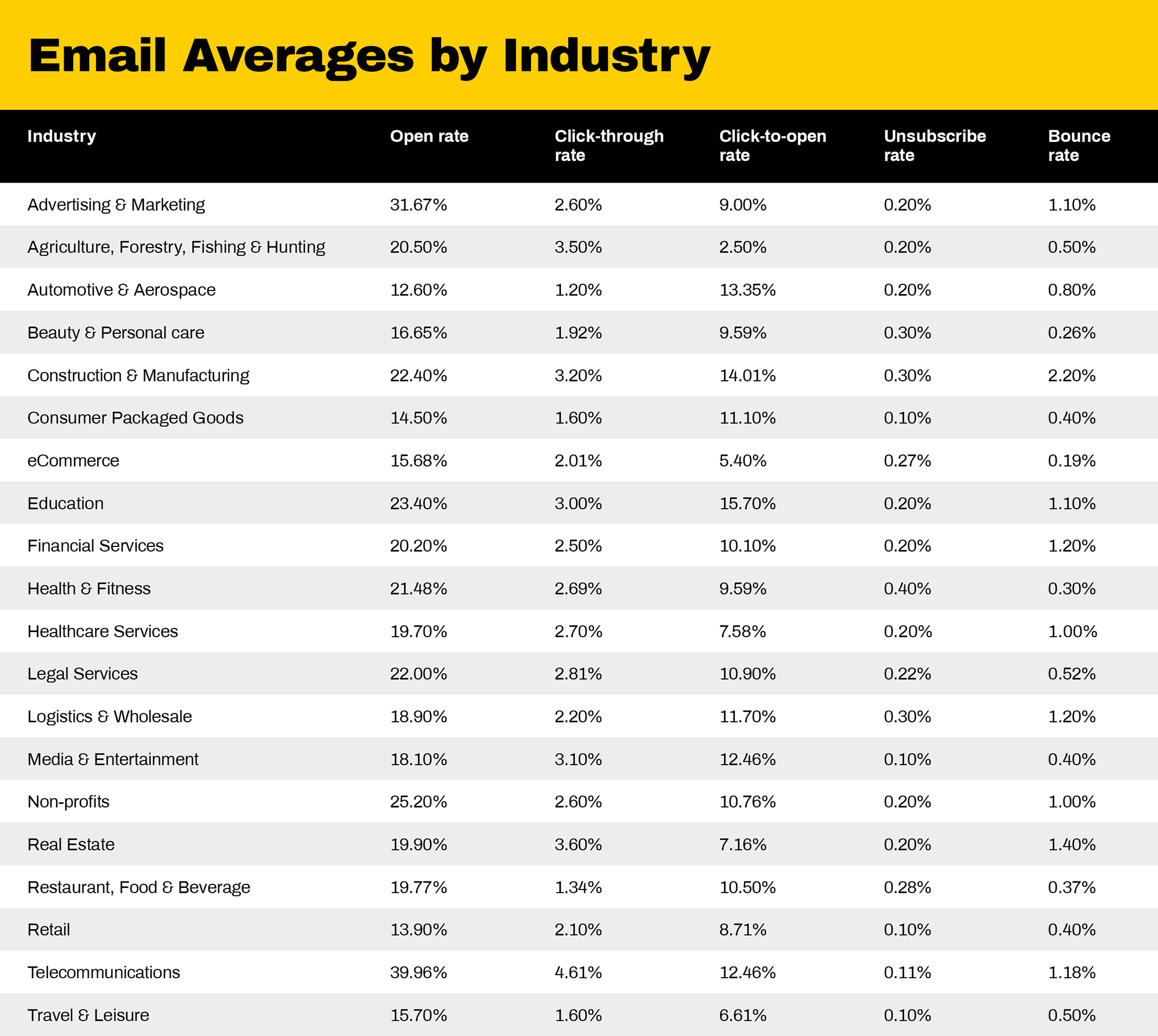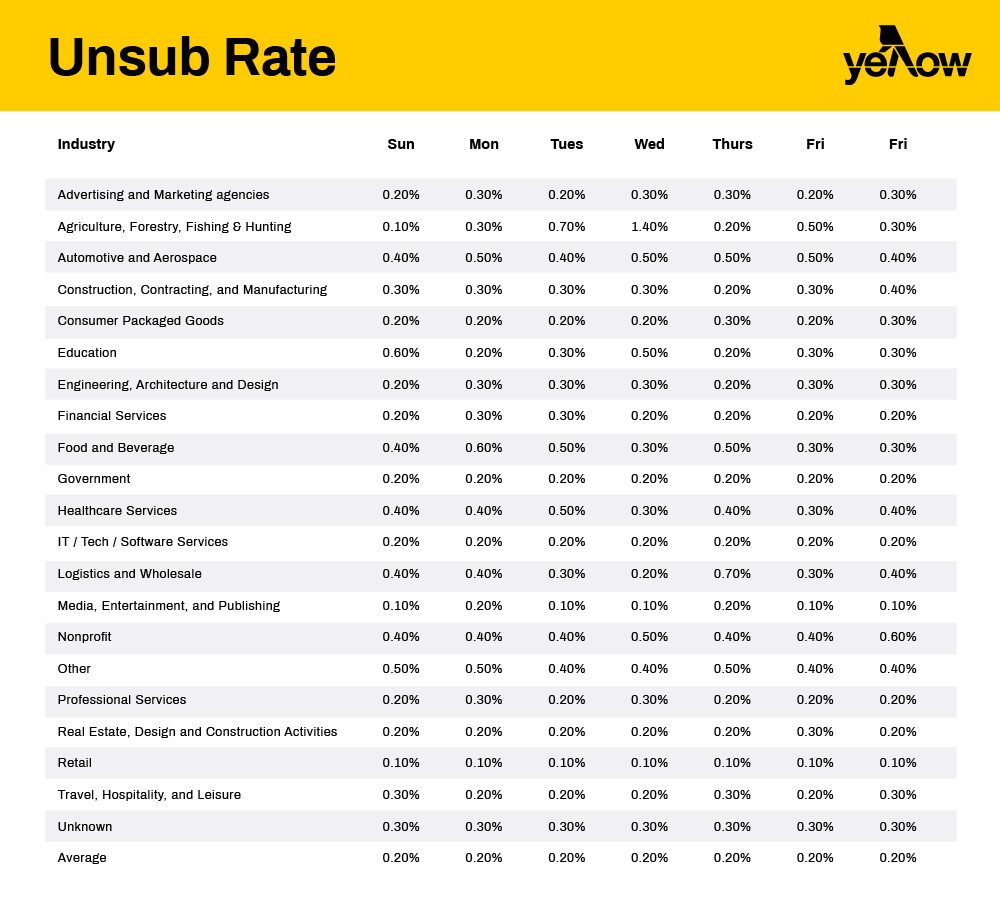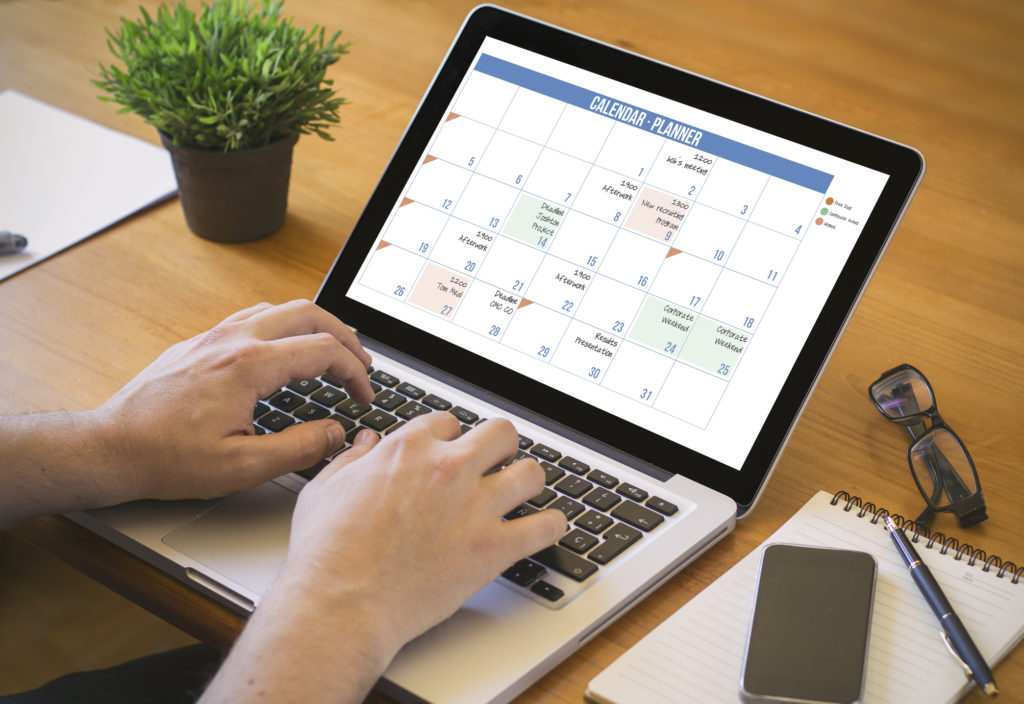The inbox is a crowded place these days. Between work messages, catch-ups with friends and family and countless promotional emails, it’s tricky to get your brand’s message to stand out.
When you’re marketing to your customers, email is one of the best tools at your disposal. However, adding an email address to your database is only half the battle. Once you’ve got your mailing list sorted, you need to make sure your message is opened and the content inside is compelling enough for people to click.
And it’s worth the effort – 66% of consumers have made a purchase as a direct result of an email marketing message.
If you’re scratching your head as to how to improve your open and click-through rates, stay calm! We’ve got you covered. These email marketing tips will help you get your message seen by more people, get more enquiries coming in and help grow your business.
What is a good open and click-through rate?
Before jumping into how to improve your email marketing, it’s a good idea to have a grasp of what makes a good open rate and click-through rate. While every industry varies slightly, there are some rough numbers you can use to benchmark your email newsletter performance compared to the average.
According to Campaign Monitor, the average open rate (OR) in Australia is 18.7%. However, this number changes a lot depending on which industry you’re in. Businesses in the education, automotive and non-profit sectors generally have a much higher open rate than those in retail or hospitality.
Meanwhile, the average click-through rate (CTR) sits at around 2.8%, although this also varies dramatically between industries. Education and nonprofits have a CTR above 4%, while those in retail, hospitality and consumer packaged goods average between 1.4% and 1.6%.
If you’re curious, here’s a look at the average email open rate, click-through rate and click-to-open ratio by industry:

Looking at industry benchmarks is a helpful way to get an idea of your email marketing performance.
How to calculate open rate: (Number of opened emails ÷ number of people the email was sent to) x 100
Example: (100 emails opened ÷ 1000 email recipients) x 100 = 10% open rate
How to calculate click-through rate: (Total number of clicks ÷ number of emails sent) x 100
Example: (50 total clicks ÷ 1000 emails sent) x 100 = 5% open rate
If your performance is above average, chances are you have a solid and engaged mailing list with loyal customers and high-quality leads. On the other hand, if your open and click-through rates are leaving a little bit to be desired, it might be time to revisit your email marketing strategy.
RELATED: eBook: the small business guide to customer relationship management (CRM).
Check your unsubscribe rate.
This is the rate at which your email recipients are unsubscribing on any given email, expressed as a percentage. A high unsubscribe rate is obviously not ideal and might suggest that your emails lack relevance to your audience, or that you’re sending emails too frequently.
How to calculate it: (Number of unsubscribes ÷ number of emails sent) x 100
Example: (5 unsubscribes ÷ 1000 emails sent) x 100 = 0.5% unsubscribe rate
Average unsubscribe rate in Australia by industry and day:

Aim for a high conversion rate.
A conversion is the ultimate action you want email recipients to take after opening an email. For example, you might want recipients to click on a link within your email and fill in a form on your website, or buy a product.
The conversion rate is the percentage of email recipients who took that desired action, expressed as a percentage.
How to calculate it: (Number of people who completed the desired action ÷ number of emails delivered) x 100
Example: 50 people who completed the desired action ÷ 1000 emails sent x 100 = 5% conversion rate
Note: There are no hard-and-fast industry benchmarks for conversion rates because a ‘conversion’ can be defined in many ways. It’s a good idea to set your own benchmarks once you begin to understand the norm for your business.
Measure your ROI.
This is a measure of the overall return on investment for your email marketing campaigns. In other words, it’s the total revenue made divided by the total amount spent on an email campaign.
How to calculate it: There are several methods for calculating ROI, but one of the most basic formulas is as follows:
[(Amount of additional sales made – the amount invested in the campaign) ÷ amount invested in the campaign] x 100
Example: $1,000 in additional sales – $200 invested in the campaign ÷ $200 invested in the campaign) x 100 = a 400% return on investment
Note: Like a conversion rate, it’s good to set your own benchmarks for ROI depending on how much you’re willing to spend on email marketing versus how much you expect to get in return.
The aim is to increase your overall ROI by optimising your email campaigns using insights gleaned from the metrics above.

How to build an email marketing strategy.
Done right, email campaigns are an absolute winner for your business. Studies show that for every $1 spent on email marketing you get $38 in return on investment.
Yep, you read that right.
From all the marketing platforms out there, email marketing delivers one of the highest returns, beating out social media, paid search and display advertising. But to reap the benefits, you need to have a solid strategy in place.
If you want to use email to win more business, these steps will help you build solid foundations for your email marketing plan.
1. Take a look at your current performance.
Already sending emails through email marketing software? Great. It’s time to take a deep dive into your EDM performance and figure out what’s working — and what you can improve on.
Take a look at some essential stats, including:
- Total mailing list size
- Average open rate
- Average click-through rate
- Average click-to-open ratio – this looks at how many people have clicked on the content in your email, relative to those that opened it.
- Average unsubscribe rate
- Average bounce rate – this is the number of subscribers that didn’t get your email because their provider returned the email back to you, similar to a Return to Sender message for direct mail.
Compare these to the industry averages above to get an idea of where your performance stands.
At the same time, try to look at trends over time:
- Are your open rates increasing or decreasing?
- Do you get better open rates at a certain time of day?
- Which type of content performs best?
These numbers will help you get an idea of what you need to focus on moving forward, in order to boost your open and click-through rate.
2. Segment your subscribers.
Everybody wants to get a message that’s relevant to their interests and tailored for them. If you want to nail your email marketing, you can’t do it without segmentation.
Segmentation helps you target a specific group of people with a tailored message. It could be as simple as sending separate email newsletters to your leads and existing customers. However, if you have more detailed data at your fingertips, you can create email newsletters based on their interests, purchasing history, content preferences and more.
When you’re creating your strategy, start by thinking about your segmentation, then craft your newsletter — not the other way around. This simple switch in thinking will help you send more targeted, relevant emails and, in turn, increase your open and click-through rates.

3. Build out your email marketing calendar.
With an idea of your targeting possibilities and a clear idea of your past performance, it’s time to get to work fleshing out your plan for the year.
Start by pinpointing important dates for your business. If you’re in retail, this could be key sales periods such as Mother’s Day or a Christmas sale. Meanwhile, if you’re running a beauty business, it might be formal season or the lead-up to summer. These are crucial moments where an email newsletter can help you connect with customers and leads, and drive business.
If you need help planning it out, grab Yellow Pages’ free email campaign planner template. This is a handy starting point to help you map out your email marketing plan, then track the results.
How to improve your email marketing open and click-through rate.
The path to improving your click-through rate also depends on your open rate. After all, the more people that open your email, the more can click on the content inside. If a person never opens your email, the rest doesn’t matter.
If you want your content to reach more people on your mailing list, these email marketing tips should help you along.
RELATED: 8 examples of brilliant email marketing campaigns.
1. Collect more data.
If you’re not asking website visitors to opt in to receiving emails, you’re missing out on valuable opportunities to get in touch with customers. Pop a link to subscribe on your website.
At the same time, make sure to collect customer data in-store at the time of purchase. These people have already purchased from you — making them prime ambassadors for your business in the future.
2. Focus on your subject line.
Want to get more opens? Work on your subject line. Data revealed that a third of all people say a subject line is the single most important factor in opening emails. On top of that, two-thirds will mark it as spam based on the subject alone.
While mastering subject lines feels like an art, there are a few things you can do to prime your subject line for opens:
- Use personalisation. Emails with a personalised subject line are 26% more likely to be opened.
- Keep it short. Most email apps or websites will cut off subject lines that are too long. Campaign Monitor found that the optimal subject line length for iPhones is 41 characters, while Gmail is roughly 70 characters.
- Avoid spam trigger words. Terms like ‘Double your…’ and $$$ signs will send your email straight to the junk box.
3. Use preview text.
Preview text is the snippet of content that appears in your email preview pane. In your inbox, it looks like this:

Many businesses forget to create preview text, or leave it as the default ‘View this email in your browser’. However, this little sentence can have a big impact on your open rates. A study by Litmus also found that almost a quarter of people look at the preview text before deciding to open an email.
Next time you’re crafting your newsletter, don’t forget to write preview text. Keep it between 40-130 characters long so it appears on mobile and desktop, and use it as a teaser for the content inside.
4. Don’t forget about your sender name.
If your open rates are lower than expected, it could be because of something as simple as your sender name. Because people get so much spam these days, they might not open your email if they don’t trust the sender.
Luckily, there’s a simple fix for this: hop on to your email marketing platform and make sure your sender name looks professional and trustworthy. Opt for the name of your business or, for a more personal touch, combine your name with the name of your company: for example, Anna from Yellow Pages.

5. Optimise for mobile.
Today, more than half of all emails are read on mobile phones. Time is precious, and if your design isn’t optimised for mobile, people might simply give up and click out of the email.
Whether you’re coding from scratch or using email marketing templates, keep these tips in mind to optimise for mobile:
- Use a responsive design that works across mobile and desktop. This means your content will scale depending on the size of the screen it’s being opened on.
- Make it easily scanned. Most people will be reading emails on the go. Help them find the information they’re looking for with clear subheadings, keep text short and break up the email with images.
- Test on mobile as well as desktop. When you send a test email to yourself, open it on your email client. This way, you can check that everything looks as it should on the small screen.
6. Include a clear call-to-action (CTA).
It might seem incredibly simple, but one of the best ways to win the click is to tell them to click. Be clear on what you want people to do — for example, a button that says ‘Click here’ or ‘View more’ — and they’ll be more likely to do it.
At the same time, make your call-to-action as obvious as possible. Put your CTA on a button, underline it, or pop an arrow next to it to ensure readers know it’s a clickable link.
7. Figure out the best time to send emails.
When it comes to email, timing matters a lot. Emails sent on a Tuesday afternoon might perform better than emails on a Friday night or Monday morning.
Campaign Monitor has a handy benchmark of the best days to send emails; however, it ultimately comes down to your subscriber behaviour. Look at your previous performance and industry benchmarks, then test out different send times to see when the best time is to send emails.
8. Test and learn.
Testing and learning is one of the most effective ways to improve your open and click through rates. In most email marketing platforms, you can run A/B tests on your subject line, send times, the content within your email, or all of the above. Start with a hypothesis and test one thing at a time. Evaluate the results, test again, then implement your findings for future emails.
9. Mix up your approach.
Promotional and/or relational emails are a good way to test the email marketing waters.
Promotional emails deliver news on an offer. This could include a flash sale, exclusive discount, EOFY clearance, refer a friend – anything to do with encouraging a customer purchase. Everyone loves a good deal and it’s no different in email marketing. Just make sure your offer is valuable enough to make an impact and avoid using hard sell words like ‘free’, ‘$’, ‘discount’ in your subject line, as this can push your email into spam folders.
On the other side of the coin, there are relational emails. Email is a powerful communication tool— helping to build strong relationships with customers and keep them up-to-date with the latest information about your business, so it shouldn’t always be about the sell.
‘Soft’ AKA relational emails involve anything from sending a newsletter, to a welcome email, to providing free content, to a birthday message. There doesn’t have to be a selling point in the email, instead, it’s about engaging your customers and building a connection, so they’re more likely to consider your services over another provider.
The takeaway? Establish an ongoing connection with your customers via relational emails and pepper this with the occasional promotional email to give customers the opportunity to directly purchase your product or services.
10. Clean your email list.
If you’ve tried everything and your open rates still aren’t going up, it could be time to spring clean your email list. Over time, people naturally might become less engaged with the content you’re sending, or they might switch email addresses — leaving you with a bunch of ‘dead’ subscribers in your list.
Every six months or one year, take a look at your subscriber activity to identify any subscribers who haven’t opened your emails in a while. Send out a re-engagement email to these people to check-in and see if they’re still keen to receive your emails. While you might have a few unsubscribes, this ensures that the people who remain on your list really want to be there.
